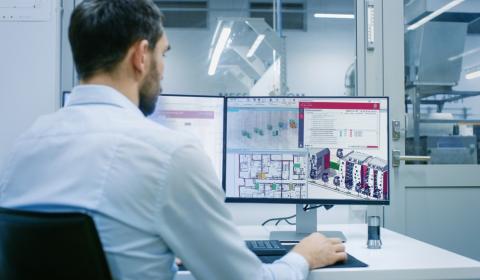
From asset design to management, BIM is revolutionizing complex projects
BIM (Building Information Modeling, or Building Information Management) is not a new technology, but its collaborative applications are in the process of revolutionizing the construction sector and, more broadly, urban development and the town of the future. A profound vector for change enhancing the end quality of projects, it may also - and above all - be the accelerator the sector was waiting in order to fully engage its digital transformation.
As a telltale sign of what the future holds, some regulations, starting with those in force in the USA and China, already stipulate its use, while in the UK, Norway and Singapore, BIM is one of the essential pre-requisites for access to government contracts. Other countries still – including France – strongly recommend it. Of course, this momentum can be explained by the rationalization of costs and operations and the final quality control afforded by BIM during the program design, construction and operation phases. Moreover, the cluster of maturing technologies underpinning BIM gives it a new collaborative dimension. On a project as iconic as that of the future Shanghai Planetarium for which Bureau Veritas is BIM manager, the hundreds of stakeholders are working on a single model in six dimensions.
This ultra-complex model is the single point of access to information about the structure. Alongside the three spatial dimensions are the dimensions of time (with actions associated with the project and user behavior), financial flows and materials aging. Each modification implemented on the ground is recorded by drones and inspection teams every two days, then “injected” into a digital double, reflecting in almost real time the status of the project, while improving the safety of structures and processes.
BIM, collective intelligence catalyst
A central medium making it possible to manage the flows of materials, work, energy and people, etc.: it is important to realize that collaborative BIM is nothing without the collective intelligence taking ownership of it. It is its catalyst, both field and common language, enabling all trades and areas of expertise to talk to each other, understand one another and interact for the benefit of the project. Everyone works together on a digital model that now constitutes the interactive and evolving frame of reference for the structure in question.
By removing the barriers between construction sites and offices, BIM is the springboard the sector was waiting for in order to fully engage its digital transformation. Information, which is constantly updated, flows efficiently throughout the life cycle of the structure. Material stocks and flows are optimized, conflicts are detected upstream thanks to digital model predictions, and costs — both in terms of time, expenditure and ecological footprint — are considerably reduced. With a project on the scale of the future Shanghai Planetarium, 60% of problems were detected upstream; and 70% of them were solved directly using BIM.
BIM thus creates the conditions required to unite the entire chain and move all its stakeholders forward. In addition to the Shanghai Planetarium, most large-scale projects – the Louis Vuitton Foundation, the Grand Paris project, etc. – have benefited from or are today exploiting the lever of trust and value creation represented by BIM. And this is just the beginning. Because while already apparent at the upstream stage, the new benefits afforded by collaborative BIM in the operational phase, in terms of predictive and preventive maintenance, reduced energy consumption and building management, will be just as invaluable. A new chapter is set to begin for BIM.